
(a)
Interpretation:
The product of the given reaction is to be predicted.
Concept introduction:
Chromic acid will oxidize a primary alcohol to a
Answer to Problem 19.56P
The product of the given reaction is
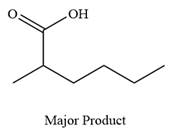
Explanation of Solution
The given reaction is

This is an example of an oxidation of a primary alcohol using sodium dichromate in aqueous acid. Chromic acid oxidizes a primary alcohol into corresponding carboxylic acid. The reaction is shown below:

Thus, carboxylic acid is the major product of the reaction.
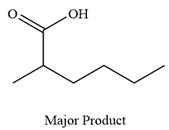
Chromic acid oxidizes a primary alcohol into corresponding carboxylic acid.
(b)
Interpretation:
The product of the given reaction is to be predicted.
Concept introduction:
Chromic acid will oxidize a primary alcohol to a carboxylic acid or a secondary alcohol to a ketone. Chromic acid is prepared by dissolving sodium dichromate in an acidic solution.
Answer to Problem 19.56P
The product of the given reaction is
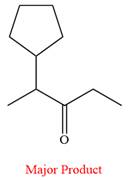
Explanation of Solution
The given reaction is
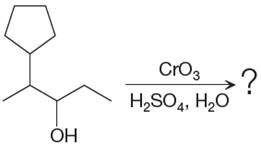
This is an example of an oxidation of a secondary alcohol using chromium trioxide in aqueous acid. Chromic acid oxidizes a secondary alcohol into corresponding ketone. The reaction is shown below:
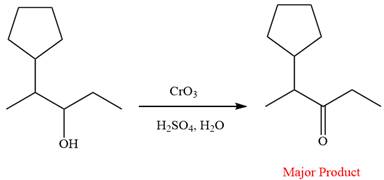
Thus, ketone is the major product of the reaction.
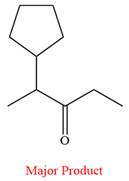
Chromic acid oxidizes a secondary alcohol into corresponding ketone.
(c)
Interpretation:
The product of the given reaction is to be predicted.
Concept introduction:
Chromic acid will oxidize a primary alcohol to a carboxylic acid or a secondary alcohol to a ketone. Chromic acid is prepared by dissolving sodium dichromate in an acidic solution. Oxidation of chromic acid requires an
Answer to Problem 19.56P
There is no product of the given reaction, as chromic acid cannot oxidize tertiary alcohols.
Explanation of Solution
The given reaction is
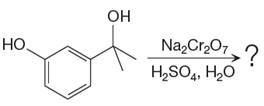
This is an example of an oxidation of a secondary alcohol using chromium trioxide in aqueous acid. Chromic acid oxidizes a secondary alcohol into corresponding ketone. Oxidation of chromic acid requires an

There is no product of the given reaction, as chromic acid cannot oxidize tertiary alcohols.
Chromic acid cannot oxidize tertiary alcohols as in tertiary alcohols carbon atom which is attached to the hydroxyl group does not have any hydrogen atom attached.
(d)
Interpretation:
The product of the given reaction is to be predicted.
Concept introduction:
Chromic acid will oxidize a primary alcohol to a carboxylic acid or a secondary alcohol to a ketone.
Answer to Problem 19.56P
The product of the given reaction is
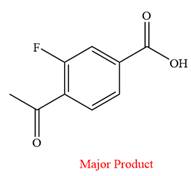
Explanation of Solution
The given reaction is
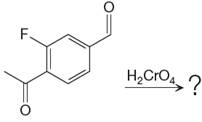
This is an example of an oxidation reaction using chromic acid. The reactant molecule has both an aldehyde and a ketone group. Chromic acid oxidizes an aldehyde group into carboxylic acid but is not a sufficiently strong oxidizing agent to oxidize ketones.
The reaction is shown below:
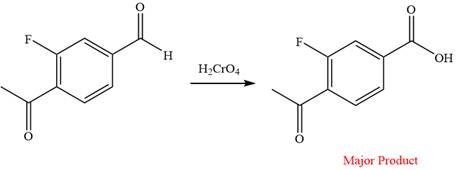
Thus, a carboxylic acid is the major product of the reaction.
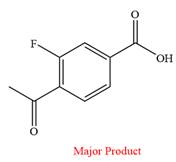
Chromic acid oxidizes an aldehyde to corresponding carboxylic acid but cannot oxidize a ketone.
(e)
Interpretation:
The product of the given reaction is to be predicted.
Concept introduction:
Like chromic acid, potassium permanganate is also used as an oxidizing agent. When treated with a basic solution of potassium permanganate (
Answer to Problem 19.56P
The product of the given reaction is
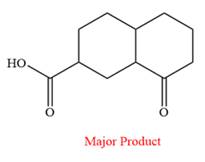
Explanation of Solution
The given reaction is
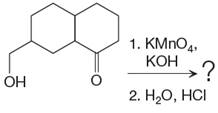
This is an example of an oxidation reaction using potassium permanganate. Like chromic acid, potassium permanganate is also used as an oxidizing agent. When treated with a basic solution of potassium permanganate (
The reaction is shown below:

Thus, the major product of the given reaction is

When treated with a basic solution of potassium permanganate (
(f)
Interpretation:
The product of the given reaction is to be predicted.
Concept introduction:
Pyridinium chlorochromate (PCC) is a partial oxidizing agent. Oxidation of a primary alcohol by pyridinium chlorochromate (PCC) stops at the aldehyde because the reaction takes place in a nonaqueous medium. Pyridinium chlorochromate (PCC) oxidizes a primary alcohol to an aldehyde and a secondary alcohol to a ketone.
Answer to Problem 19.56P
The product of the given reaction is
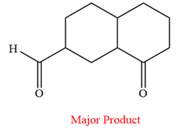
Explanation of Solution
The given reaction is

This is an example of an oxidation reaction using pyridinium chlorochromate (PCC). Like othe oxidizing agents, pyridinium chlorochromate (PCC) oxidizes a primary alcohol to an aldehyde and a secondary alcohol to a ketone.
The reaction is shown below:

Thus, the major product of the given reaction is
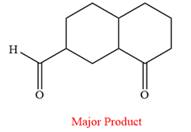
Pyridinium chlorochromate (PCC) oxidizes a primary alcohol to an aldehyde and a secondary alcohol to a ketone.
Want to see more full solutions like this?
Chapter 19 Solutions
Organic Chemistry: Principles and Mechanisms (Second Edition)
- What would be the best choices for the missing reagents 1 and 3 in this synthesis? 1 1. PPh3 2. n-BuLi 2 • Draw the missing reagents in the drawing area below. You can draw them in any arrangement you like. • Do not draw the missing reagent 2. If you draw 1 correctly, we'll know what it is. • Note: if one of your reagents needs to contain a halogen, use bromine. Click and drag to start drawing a structure.arrow_forwardThe product on the right-hand side of this reaction can be prepared from two organic reactants, under the conditions shown above and below the arrow. Draw 1 and 2 below, in any arrangement you like. 1+2 NaBH₂CN H+ N Click and drag to start drawing a structure. X $arrow_forwardExplain what is the maximum absorbance of in which caffeine absorbs?arrow_forward
- Explain reasons as to why the amount of caffeine extracted from both a singular extraction (5ml Mountain Dew) and a multiple extraction (2 x 5.0ml Mountain Dew) were severely high when compared to coca-cola?arrow_forwardProtecting Groups and Carbonyls 6) The synthesis generates allethrolone that exhibits high insect toxicity but low mammalian toxicity. They are used in pet shampoo, human lice shampoo, and industrial sprays for insects and mosquitos. Propose detailed mechanistic steps to generate the allethrolone label the different types of reagents (Grignard, acid/base protonation, acid/base deprotonation, reduction, oxidation, witting, aldol condensation, Robinson annulation, etc.) III + VI HS HS H+ CH,CH,Li III I II IV CI + P(Ph)3 V ༼ Hint: no strong base added VI S VII IX HO VIII -MgBr HgCl2,HgO HO. isomerization aqeuous solution H,SO, ༽༽༤༽༽ X MeOH Hint: enhances selectivity for reaction at the S X ☑arrow_forwardDraw the complete mechanism for the acid-catalyzed hydration of this alkene. esc 田 Explanation Check 1 888 Q A slock Add/Remove step Q F4 F5 F6 A བྲA F7 $ % 5 @ 4 2 3 & 6 87 Click and drag to start drawing a structure. © 2025 McGraw Hill LLC. All Rights Reserved. Terms of Use | Privacy Ce W E R T Y U S D LL G H IK DD 요 F8 F9 F10 F1 * ( 8 9 0 O P J K L Z X C V B N M H He commandarrow_forward
- Explanation Check F1 H₂O H₂ Pd 1) MCPBA 2) H3O+ 1) Hg(OAc)2, H₂O 2) NaBH4 OH CI OH OH OH hydration halohydrin formation addition halogenation hydrogenation inhalation hydrogenation hydration ☐ halohydrin formation addition halogenation formation chelation hydrogenation halohydrin formation substitution hydration halogenation addition Ohalohydrin formation subtraction halogenation addition hydrogenation hydration F2 80 F3 σ F4 F5 F6 1 ! 2 # 3 $ 4 % 05 Q W & Å © 2025 McGraw Hill LLC. All Rights Reserved. F7 F8 ( 6 7 8 9 LU E R T Y U A F9arrow_forwardShow the mechanism steps to obtain the lowerenergy intermediate: *see imagearrow_forwardSoap is made by the previous reaction *see image. The main difference between one soap and another soap isthe length (number of carbons) of the carboxylic acid. However, if a soap irritates your skin, they mostlikely used too much lye.Detergents have the same chemical structure as soaps except for the functional group. Detergentshave sulfate (R-SO4H) and phosphate (R-PO4H2) functional groups. Draw the above carboxylic acidcarbon chain but as the two variants of detergents. *see imagearrow_forward
 ChemistryChemistryISBN:9781305957404Author:Steven S. Zumdahl, Susan A. Zumdahl, Donald J. DeCostePublisher:Cengage Learning
ChemistryChemistryISBN:9781305957404Author:Steven S. Zumdahl, Susan A. Zumdahl, Donald J. DeCostePublisher:Cengage Learning ChemistryChemistryISBN:9781259911156Author:Raymond Chang Dr., Jason Overby ProfessorPublisher:McGraw-Hill Education
ChemistryChemistryISBN:9781259911156Author:Raymond Chang Dr., Jason Overby ProfessorPublisher:McGraw-Hill Education Principles of Instrumental AnalysisChemistryISBN:9781305577213Author:Douglas A. Skoog, F. James Holler, Stanley R. CrouchPublisher:Cengage Learning
Principles of Instrumental AnalysisChemistryISBN:9781305577213Author:Douglas A. Skoog, F. James Holler, Stanley R. CrouchPublisher:Cengage Learning Organic ChemistryChemistryISBN:9780078021558Author:Janice Gorzynski Smith Dr.Publisher:McGraw-Hill Education
Organic ChemistryChemistryISBN:9780078021558Author:Janice Gorzynski Smith Dr.Publisher:McGraw-Hill Education Chemistry: Principles and ReactionsChemistryISBN:9781305079373Author:William L. Masterton, Cecile N. HurleyPublisher:Cengage Learning
Chemistry: Principles and ReactionsChemistryISBN:9781305079373Author:William L. Masterton, Cecile N. HurleyPublisher:Cengage Learning Elementary Principles of Chemical Processes, Bind...ChemistryISBN:9781118431221Author:Richard M. Felder, Ronald W. Rousseau, Lisa G. BullardPublisher:WILEY
Elementary Principles of Chemical Processes, Bind...ChemistryISBN:9781118431221Author:Richard M. Felder, Ronald W. Rousseau, Lisa G. BullardPublisher:WILEY





